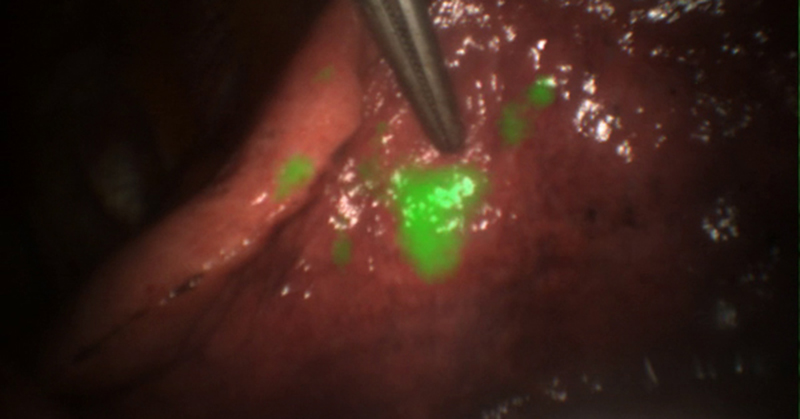An experimental cancer imaging tool that makes tumors glow brightly during surgery has shown promise again in a new Penn Medicine clinical study, this time in patients with brain cancer. The fluorescent dye technique, originally developed by surgeons at the Penn Center for Precision Surgery to treat lung cancer, illuminated brain tumors in real-time during surgery, helping physicians distinguish between healthy and cancerous tissue. Each year, over 15,000 people in the United States undergo surgeries to remove brain tumors.
Findings from the pilot study, led by first author John Y.K. Lee, MD, MSCE, an associate professor of Neurosurgery in the Perelman School of Medicine at the University of Pennsylvania, and co-director of the Center for Precision Surgery, were reported in this week in Neurosurgery.
A big challenge with brain surgery is ensuring the entire tumor is removed. It is difficult to identify the margins of the tumor with current approaches. Cancer tissue not visible to the naked eye or felt by fingers is often missed during tumor removal, leading to recurrence in some patients – about 20 to 50 percent.
Penn’s approach, which relies on an injectable dye that accumulates in cancerous tissues more so than normal tissues, may help change that.
“Fluorescent contrast agents take visualization to a whole new level,” Lee says. “It has the potential for real-time imaging, identification of disease, and most importantly, precise detection of the tumor’s margins. With this, we know better where to cut.”

(Image credit: University of Pennsylvania School of Medicine)
The study also includes co-author, Sunil Singhal, MD, an associate professor of Surgery, and co-director the Center for Precision Surgery at Penn’s Abramson Cancer Center, who first started work on this approach in his lab nearly 10 years ago.
The technique uses near-infrared, or NIR, imaging and the contrasting agent indocyanine green (ICG), which fluoresces a bright green under NIR light. ICG was developed during World War II as a dye in photography and, in 1958, it was approved by the U.S. Food and Drug Administration (FDA) for use in medicine, primarily in liver diagnostics and later in cardiology.
However, for this study, researchers used a modified version of ICG at a higher concentration delivered intravenously about 24 hours before surgery to ensure margins were included. This is the first time, to the authors knowledge, that this delayed imaging of ICG has been used to visualize brain tumors.
Patients enrolled in the clinical study were between the ages of 20 and 81 with a diagnosis of a solitary brain tumor and a presumed glioma based on imaging or prior surgery or biopsy.
Twelve of the 15 tumors demonstrated strong intraoperative fluorescence. The lack of glow in the three remaining tumors could potentially be due to their disease grade and timing of the injection, the authors suggested.
Eight of the 15 patients demonstrated a visible glow through the dura, a thick membrane on the meninges of the brain, was opened, demonstrating the technology’s ability to see deeply within the brain before the tumor is exposed. Once opened, all tumors were picked up by NIR imaging.
The researchers also studied the surgical margins using neuropathology and magnetic resonance imaging, (MRI) to assess the accuracy and precision of NIR fluorescence in identifying tumor tissue.
Of the 71 specimens collected from MRI-enhanced tumors and their surgical margins, 61 (85.9 percent) fluoresced and 51 of these (71.8 percent) were classified as glioma tissue
Of the 12 MRI-enhancing gliomas, four patients had biopsy specimens that were both non-fluorescent and negative for tumor, which matched the gross total resection seen on their MRI. In contrast, 8 patients had residual fluorescent signal in the resection cavity. Only 3 of these patients showed gross total resection on MRI. This suggests a benefit of true-negative NIR signal after resection, the authors said
Over the past three plus years, Singhal, Lee, and their colleagues have performed more than 300 surgeries with the imaging tool in patients with various types of cancer, including lung, brain, bladder and breast.
“This technique, if approved by the FDA, may offer great promise to physicians and patients,” Singhal says. “It’s a strategy that could allow greater precision across many different cancer types, help with early detection, and hopefully better treatment success.”




